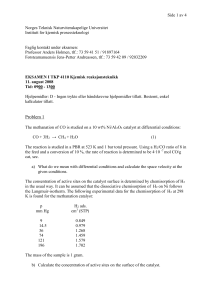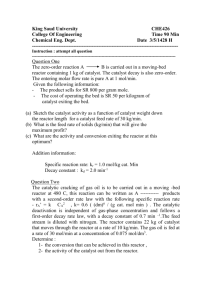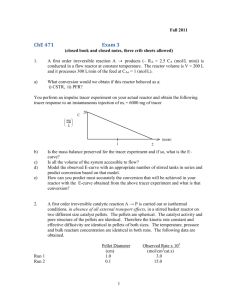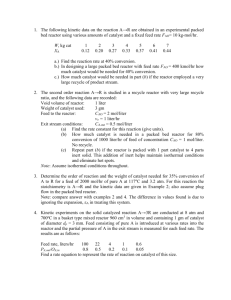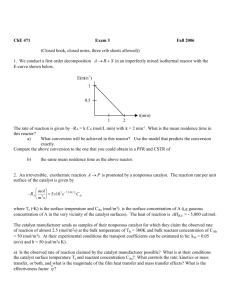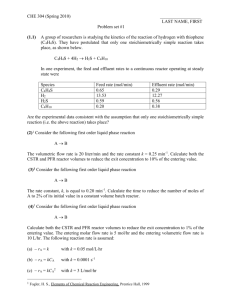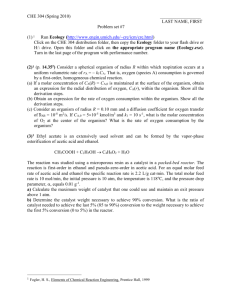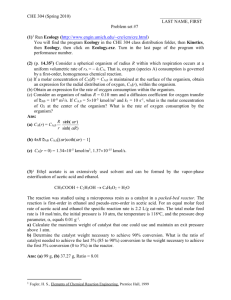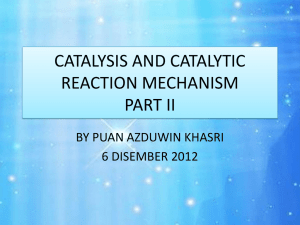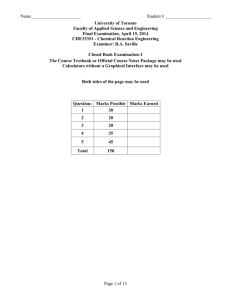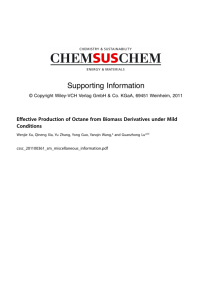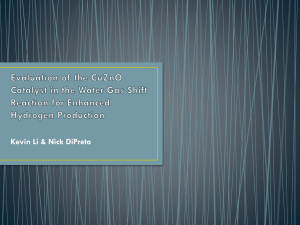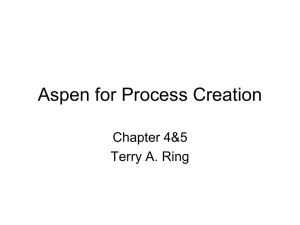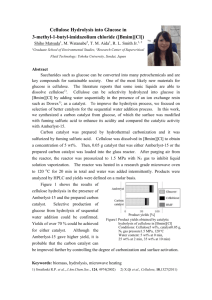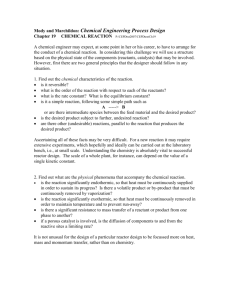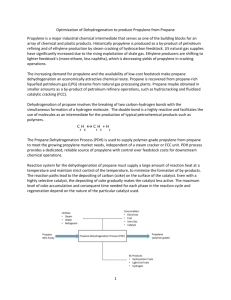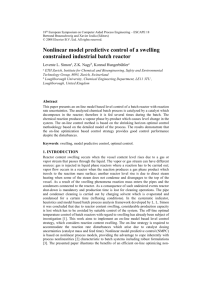Exam: Catalysis for Engineers
advertisement
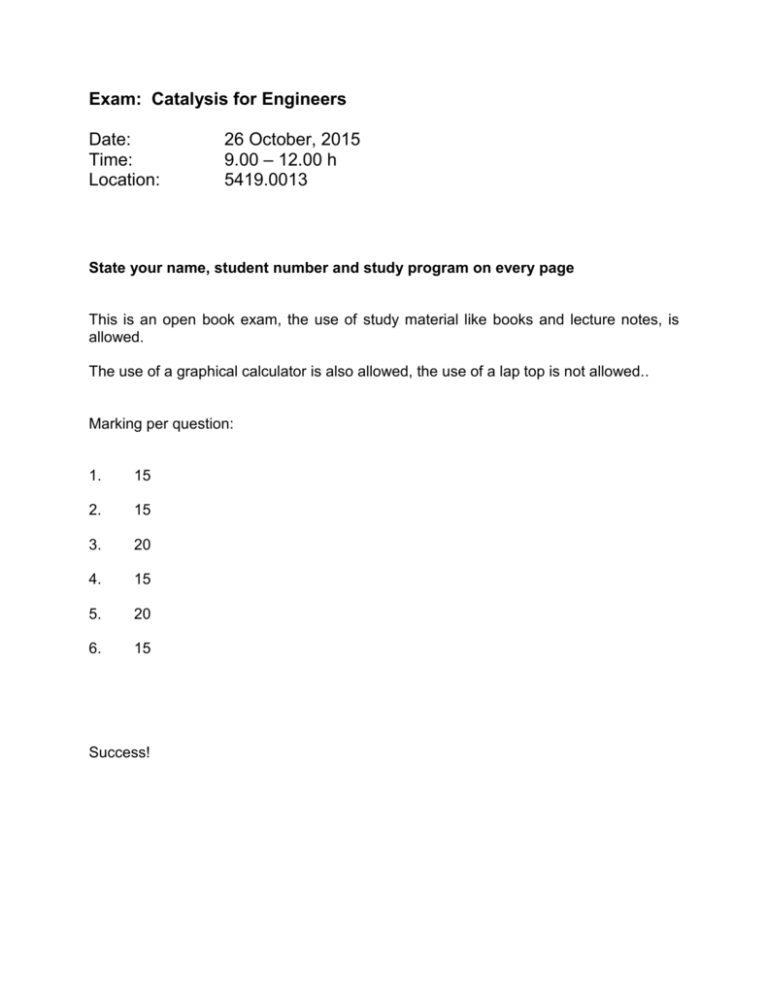
Exam: Catalysis for Engineers Date: Time: Location: 26 October, 2015 9.00 – 12.00 h 5419.0013 State your name, student number and study program on every page This is an open book exam, the use of study material like books and lecture notes, is allowed. The use of a graphical calculator is also allowed, the use of a lap top is not allowed.. Marking per question: 1. 15 2. 15 3. 20 4. 15 5. 20 6. 15 Success! Question 1. Nitrogen and hydrogen react to form ammonia in the presence of a catalyst: N2 + 3 H2 ↔ 2 NH3 The reactor in which the reaction is carried out is maintained at 450 K and 4 atm pressure and has a sufficiently long residence time so that equilibrium is achieved at the reactor exit. a. Is it beneficial to perform the reaction at high or low temperature? b. Is it beneficial to perform the reaction at high or low pressure? c. What is the value of the equilibrium constant (KP) at 450 K? d. What will be the mole fractions of nitrogen, hydrogen and ammonia exiting the reactor if stoichiometric amounts of nitrogen and hydrogen enter the reactor? Additional data: The equilibrium constant (Kp) at 273 K is 725 The heat of reaction is -38 kJ/mol (assume independent of the temperature). Question 2. Enzyme reactions may be suffering from substrate inhibition. A possible reaction scheme is given below: E + S ↔ E.S E.S → P E.S + S ↔ S.E.S a. Derive a rate equation for S using the steady state hypothesis b. Is the rate equation in line with the experimentally observed trend given below? Question 3. Assume the following gasphase equilibrium reaction which is catalyzed by an heterogeneous catalyst: A + B ↔ P Assume that the reaction proceeds via the following mechanism: A +* ↔ A* (1) B +* ↔ B* (2) A* + B* ↔ P* + * (3) ↔ P + * (4) P* a. Give the name for this mechanism and also the name for the individual steps b. Assume that the reaction at the surface is rate determining and irreversible. Derive an equation for the rate of the reaction c. Assume that the reaction at the surface is rate determining but that it is a reversible reaction. Derive an equation for the rate of the reaction. Question 4. A series of experiments were performed using various sizes of crushed catalysts to determine the importance of pore diffusion. The reaction may be assumed to be first order and irreversible. The surface concentration of reactant was 2 x 10 -4 mol/cm3. Diameter sphere 0.25 (cm) 0.075 0.025 0.0075 Robs (mol/h.cm3) 0.70 1.60 2.4 0.22 a. Determine the true rate constant k and the effective diffusion coefficient (D e) from the data. b. Predict the effectiveness factor and the observed reaction rate (R obs) for a commercial cylindrical catalyst pellet with dimensions 0.5 cm (height) x 0.5 cm (diameter) Question 5. In aqueous solution, and in contact with the right solid catalyst, reactant A is converted to product R by the elementary reaction A → 2 R. Find the mass of catalyst needed in a continuous packed bed reactor for 90% conversion of A, which is fed to the reactor at a molflow of 104 mol/h and a CA,0 of 103 mol/m3. Assume that external mass transfer does not play a role. Additional data: Kinetic constant = 4 m3/m3cat.s Diameter of the porous catalyst pellets = 6 mm Effective diffusion coefficient of A in the pellet = 4 x10-8 m3/m.cat.s Solid fraction in the packed bed = 0.5 Bulk density of the packed bed = 2000 kg/m3 bed Question 6. The water gas shift reaction is used to increase the hydrogen to CO ratio in syngas. CO + H2O ↔ CO2 + H2 ΔHR = -41 kJ/mol The reaction is typically carried out in a configuration consisting of two adiabatic reactors, one operated at higher temperature (HT shift reactor), one operating at lower temperature (LT shift reactor). The HT shift reactor uses an inexpensive Fe catalyst, the LT reactor a more expensive though, more active Cu catalyst. However, the Cu catalyst is deactivating rather rapidly. a. Should the reactors be operated at high or low pressure, Explain your answer b. Why is the LT reactor also not operated with the inexpensive Fe catalyst? c. Is the outlet temperature of the HT reactor higher or lower than the inlet temperature d. The second LT reactor contains by far more catalyst than required to achieve the desired conversion. Give an explanation.
